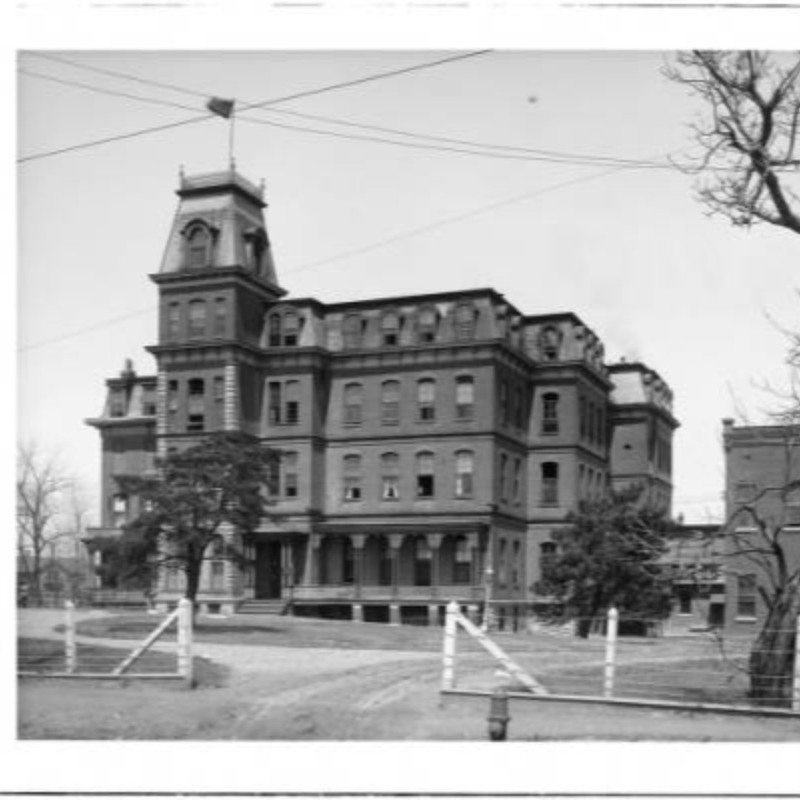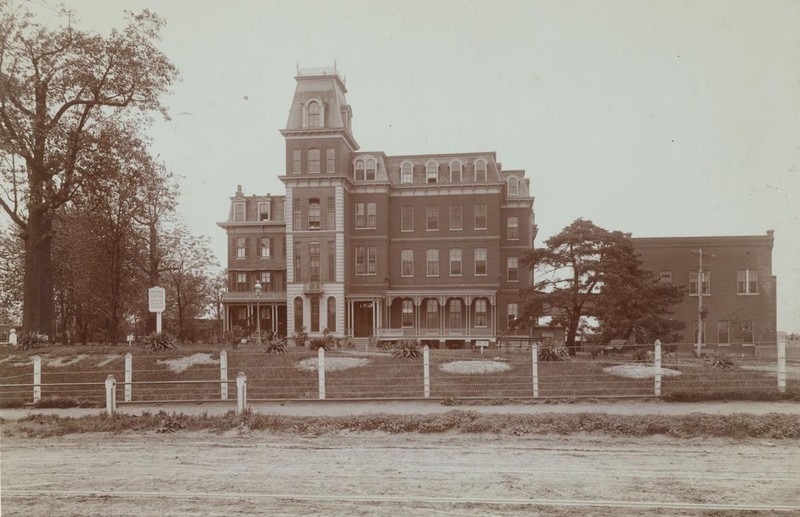Social Evil Hospital of St. Louis (1872-4); Female Hospital (1874-1910)
Introduction
Text-to-speech Audio
From the fall of 1872 until its closure in 1910, the Social Evil Hospital of St. Louis (1872-1910) was located here at the intersection of Arsenal and Sublette streets. The hospital was a place where sex workers admitted themselves to be examined and treated for sexually transmitted illnesses in accordance with the Social Evil Ordinance. This local law was repealed in 1874, and after that time, the institution was known as The Female Hospital. In 1906, the future entertainer and activist Josephine Baker was born at Female Hospital. For a short time after 1910, the former hospital served as makeshift housing for those who might have otherwise been homeless. In 1915, the building was razed as part of the larger effort to create Sublette Park.
Images
Originally known as the Social Evil Hospital, this institution was intended to prevent the spread of sexually-transmitted diseases

The building was later known as "The Female Hospital" and operated until 1910. The structure was razed in 1915.

Backstory and Context
Text-to-speech Audio
In the City of St. Louis at the turn of the century, sex workers were required to register with the city’s Board of Health. Submitting themselves to a physical examination was a requirement of this registration process. Hoping to curb what they considered illicit behavior, lawmakers wrote what they called the ‘Social Evil Ordinance’ in 1871. American Heritage writer James Wunsch observed that "The public by and large seemed to think that the new law should be given a fair trial (Wunsch)."
This ordinance was enacted to control the spread of venereal diseases by attempting to regulate and reform the practice of sex work within the city limits. The ordinance was revised in 1871 to include provisions for a hospital, which would become the Social Evil Hospital. Upkeep for this institution was paid for by a special monthly tax levied on brothels and on the sex workers themselves. If sex workers submitted themselves to regular examinations, medical treatment, and paid their fines, then they were allowed to continue plying their trade. At first, the ordinance seemed to be working well, "but administration of the law soon proved to be more than the authorities could handle (Wunsch)." Law enforcement and doctors assigned to care for these women, collect their registration fees, and ensure compliance quickly became overwhelmed with the amount of work.
Despite revisions, the Social Evil Ordinance was repealed in 1874. From the ordinance’s implementation, there was a severe backlash to the idea of legalized sex work. Many individuals claimed the ordinances encouraged the practice of sex work rather than condemning it. Others suggested that the ordinance did not include any consequences for men that were engaging the services of these sex workers. During the late 1870s, the Social Evil Hospital was renamed the Female Hospital and put under the care of Dr. Schenck, who became the Superintendent.
In the years that followed, the Female Hospital became a place of charity for women and very young children of all socioeconomic backgrounds to seek assistance. White patients in the main hospital, a large brick building at the center of the grounds, were separated into wards and not allowed to leave once assigned to a specific ward. Patients of color were kept separately from white patients in a separate two-story frame structure on hospital grounds. No men, including physicians, were allowed to live within the hospital when it was in operation. According to Dr. Schenck, “it is not what it was in the time of the old social evil law at all…The class which formerly occupied this place, almost to the exclusion of others, are now but a small percentage in it (Post-Dispatch).”
This hospital remained in operation until 1910. The building remained in close proximity to a mental asylum and a poor house. The hospital grounds were used as a makeshift home for elderly residents of the poor house, but this development was short-lived. The building itself was destroyed around 1915 to make space for what is now Sublette Park. The memory of the Social Evil Hospital lives on as a testament to what many call St. Louis's ill-fated 'experiment' with legalized sex work. Some taxpayers blamed this failure on a widespread non-compliance by sex workers and madams, while others argued that strong public opposition was the nail in the coffin of the Social Evil Ordinance. Licensed houses of sex work were never again attempted in the City of St. Louis, despite the continued belief by some that the existence of the sex work trade was an inevitable part of city living.
Sources
“Social Evil Hospital.” Bernard Becker Medical Library Digital Collection. Washington University School of Medicine, St. Louis, Missouri. http://beckerexhibits.wustl.edu/mowihsp/win/Timeline/SocialEvilHospital.htm.
"Social Evil Hospital as Female Hospital." St. Louis Post-Dispatch. March 21, 1882.
https://www.newspapers.com/clip/22164883/social-evil-hospital-as-female-hospital/
Corbett, Katharine T. In Her Place: A Guide to St. Louis Women’s History. St. Louis, Missouri. Missouri History Museum, 1999.
Crane, Caitlin. Occupation: Social Evil, Bernard Becker Medical Library at WUSTL. October 12th 2015. https://becker.wustl.edu/news/social-evil-hospital/.
Merrell, Charles. The St. Louis Social Evils Hospital, Academia.edu. https://www.academia.edu/26645241/The_St_Louis_Social_Evils_Hospital.
O'Neil, Tim. "A look back at St. Louis's brief experiment with legalized prostitution." St. Louis Post-Dispatch September 26th 2021. https://www.stltoday.com/news/archives/a-look-back-at-st-louiss-brief-experiment-with-legalized-prostitution/article_cbff5b95-42bb-5f16-a221-13aa03984301.html
Wunsch, James. The Social Evil Ordinance, American Heritage. February 1st 1982. https://www.americanheritage.com/social-evil-ordinance.
Image Courtesy of the St. Louis Public Library
Image Courtesy of the Missouri History Museum
